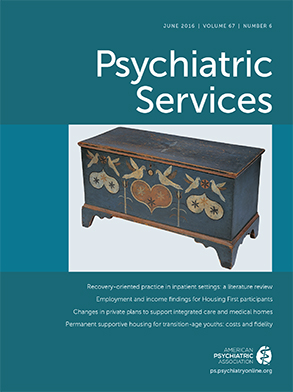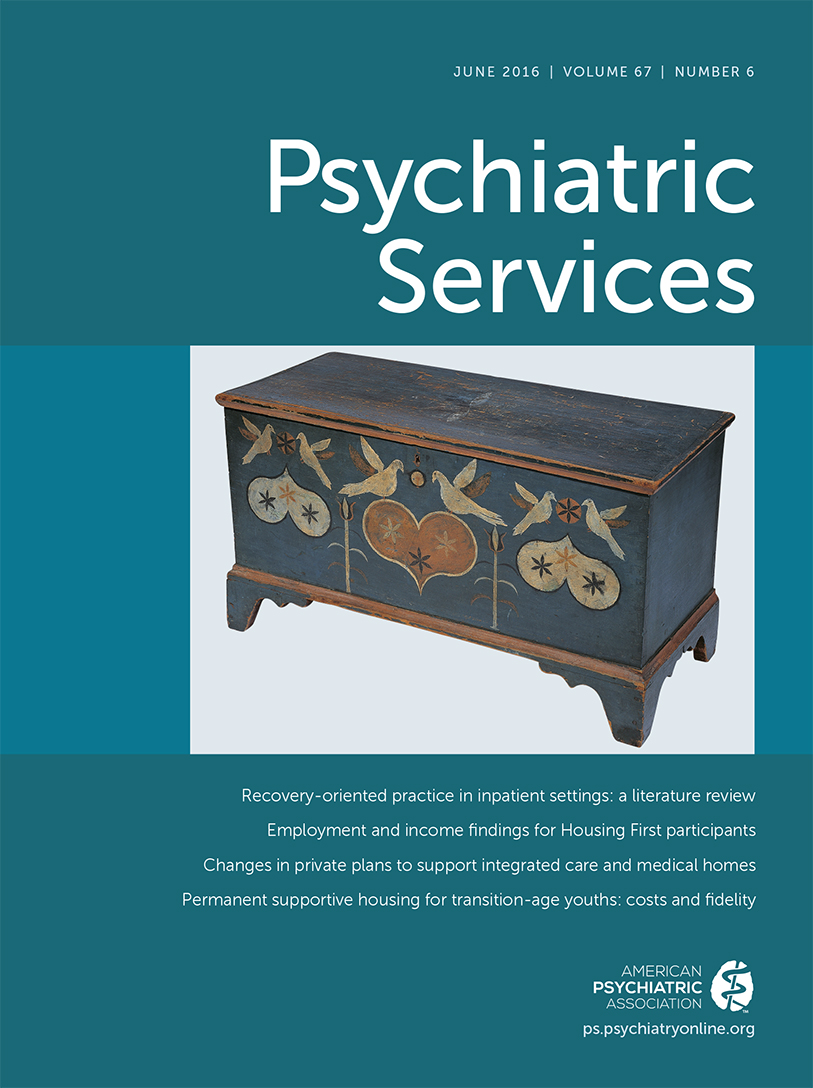Concerns about limited employment opportunities for adults with criminal records have led to the creation of various national initiatives to support the ability of ex-offenders to obtain competitive employment and to contribute to society. For example, the Ban the Box campaign has advocated for removing screening questions about criminal records on hiring applications, which has led ten U.S. states to pass legislation supporting this cause. An abundance of research has documented the limiting effect of criminal records on employment opportunities (
1,
2), especially for black individuals (
3,
4). However, there has been limited study of this topic among homeless populations. Most research has focused on the intersection between the criminal justice system and homelessness rather than on the consequences of criminal justice involvement on employment among persons who are homeless (
5,
6). Understanding the association between criminal history and employment among adults who are homeless is important, given that efforts to help persons who are homeless involve not only providing housing but also supporting community integration and the ability to contribute to the workforce (
7).
In this study, we used data from two multisite samples of homeless men—chronically homeless men and homeless veterans—to examine the association between criminal or incarceration history and employment by race. We also examined criminal or incarceration history in the context of psychiatric and substance use disorders and public-support income (for example, welfare and disability income), given that they have been found to be closely related to employment (
8–
11). It was hypothesized that criminal or incarceration history, severe mental illness, substance use disorders, and public-support income would all be negatively associated with employment and earnings for homeless men.
Methods
The first sample was composed of chronically homeless adults participating in the 11-site Collaborative Initiative to Help End Chronic Homelessness (CICH), implemented by the U.S. Interagency Council on Homelessness from 2004–2009 (
12). Eligibility criteria included being chronically homeless, defined as continuously homeless for one year or more or having at least four episodes of homelessness in the past three years. There were no exclusion criteria on the basis of incarceration history. Data were collected through interviews with participants. For this study, incarceration history was defined as any reported lifetime incarceration. This study analyzed baseline data from 569 male participants at the time of enrollment in CICH.
The second sample was composed of homeless veterans admitted to the U.S. Department of Housing and Urban Development–Veterans Affairs (VA) Supportive Housing (HUD-VASH) program in 19 sites from 1992–2003. The HUD-VASH program is the largest supported-housing program for homeless U.S. veterans. Eligibility criteria during the period of data collection included being eligible for VA services, being homeless for at least 30 days, and having a psychiatric or substance use disorder. There were no exclusion criteria related to criminal history, except sex offenders were denied admission. Data were collected through interviews with homeless veterans. For this study, criminal history was defined as any report of having been arrested and charged with a criminal offense. This study analyzed baseline data from 1,101 male participants at the time of program admission.
The CICH and HUD-VASH samples were analyzed separately. First, participants were divided into those with or without an incarceration or criminal history. Second, bivariate comparisons of the sociodemographic, psychosocial, and employment characteristics of persons with and without incarceration or criminal histories were conducted by using t tests and chi square tests. Third, multivariable analyses of the effects of incarceration or criminal history on employment variables were conducted with analyses of covariance and logistic regressions adjusted for differences in sociodemographic and psychosocial characteristics. Effect sizes were calculated for significant differences by using Cohen’s d and odds ratios (ORs) with 95% confidence intervals (CIs). Fourth, all aforementioned analyses were repeated separately for black and white participants in both samples to examine whether the results differed by race. Finally, analyses of covariance and logistic regressions were used with both the CICH and the HUD-VASH samples to construct models examining the association between incarceration and criminal history, psychiatric disorders, and public support in relation to employment variables. Statistical significance for all analyses was set at alpha=.01.
Results
There were no significant differences in the CICH sample in any employment variable or in public-support income between individuals with or without a history of incarceration (
Table 1). Multivariable tests also found no significant differences on the basis of history of incarceration for any employment variable after the analyses controlled for differences in lifetime homelessness and rates of substance use disorder. Similar results were found when analyses were conducted separately for white (N=218) and black (N=275) participants.
A model was constructed using the total CICH sample to study whether incarceration history, psychiatric disorders, and public support predicted employment variables. Posttraumatic stress disorder (PTSD) was positively associated with length of longest full-time job (F=9.50, df=1 and 549, p<.01); public-support income was negatively associated with hours worked per week in the past month (F=7.60, df=1 and 560, p<.01) and employment income in the past month (F=11.07, df=1 and 560, p<.01); and public-support income (converted to $100 units) was negatively associated with any employment in past month (OR=.90, CI=.84–.97, p<.01).
Table 1 also shows the comparison between homeless male veterans with and without criminal histories in the HUD-VASH sample. Compared with veterans without a criminal history, those with a criminal history reported holding their longest full-time job for a shorter time and were less likely to report “skilled professional” as their usual lifetime occupation. Notably, 80% (N=878) of the total HUD-VASH sample reported having a usual lifetime occupation other than skilled professional; the lifetime occupation reported most frequently (N=309, 28%) was a semiskilled job. When multivariable tests controlled for differences in psychiatric diagnoses, the longest full-time job was still held for a significantly shorter period by veterans with a criminal history (F=32.72, df=1 and 1,032, p<.001, d= .41), but there was no significant difference in the odds of reporting skilled professional for lifetime occupation (OR=.66, df=1, CI=.46–.95, p=.03).
When these analyses were repeated for only white participants (N=490), the results remained the same; participants with criminal histories held their longest full-time job for a shorter period of time compared with participants without a criminal history (F=20.11, df=1 and 462, p<.001, d=.46). Among only black participants (N=521), participants with a criminal history also reported holding their longest full-time job for a shorter period compared with participants without a criminal history (F=7.85, df=1 and 483, p<.01, d=.24). There were no significant group differences by race on any other employment variables.
Using the total HUD-VASH sample, we constructed a model using criminal history, psychiatric disorders, and public support as predictors of employment variables. Criminal history was negatively associated with length of longest full-time job (F=34.93, df=1 and 1,021, p<.001). Psychotic disorder was negatively associated with length of longest full-time job (F=8.72, df=1 and 1,021, p<.01) and days worked in past month (F=10.27, df=1 and 1,022, p<.01); public-support income was negatively associated with employment income (F=47.06, df=1 and 1,029, p<.001) and days worked in past month (F=63.37, df=1 and 1,022, p<.001). Variables negatively associated with having a job longer than a month in the past three years or having any full- or part-time job in the past three years, respectively, were psychotic disorder (OR=.38, CI=.26–.56, p<.001, and OR=.49, CI=.33–.73, p<.01), personality disorder (OR=.52, CI=.36–.74, p<.001, and OR=.51, CI=.35–.74, p<.001), and public-support income (OR=.83, CI=.79–.88, p<.001, and OR=.76, CI=.72–.80, p<.001).
Discussion
This study highlights the high rates of unemployment, incarceration or criminal history, and psychiatric and substance abuse problems among homeless men, particularly those who were chronically homeless. We found that four of five chronically homeless men did not work at all in the past month. This finding underscores the need for interventions to help homeless individuals to truly reenter society and exit homelessness by obtaining employment.
Across both samples of homeless men, incarceration or criminal history was not associated with job attainment or employment earnings for black or white participants. This finding, which contrasts with findings from populations who were not homeless (
1,
4), may be explained, in part, by the types of jobs held by many homeless participants. In our homeless veteran sample, the majority had been skilled or unskilled manual workers, occupations that may have less strict exclusion requirements related to criminal or incarceration histories compared with more professional jobs. The low levels of employment may also be explained by psychotic disorders and public-support income, both of which were negatively associated with job attainment and earnings.
The cross-sectional nature of this study precludes inferences about causality, and there were differences in measures between samples (for example, incarceration versus criminal history), so these findings need to be interpreted with caution. Nonetheless, a body of studies has shown that people with severe mental illness experience difficulties obtaining and maintaining employment because of disruptions in their education and work history (
8,
13), their symptoms and cognitive deficits (
9), and stigma and discrimination from employers (
14,
15). Given the higher rates of education and work disruptions in homeless populations, persons with severe mental illness and a history of homelessness may be particularly vulnerable to employment difficulties compared with their counterparts who are not homeless. Employment among homeless men may also be limited by a fear of losing public-support payments, but it may also be impeded by the underlying disabilities themselves, given that many public-support payments are received for health-related disabilities.
It is notable, though, that among homeless veterans, criminal history was associated with shorter duration of full-time employment for the job that they had held longest in their lifetime. This finding concerns duration of employment rather than simple job attainment, and it is unclear whether homeless veterans experienced disruptions in their work history because of their criminal history or mental health problems or whether criminal histories and mental illness made it more difficult for homeless veterans to keep a job. Further study is needed to tease out the directionality of this association.
This study relied on self-report and lacked information on the timing of criminal justice involvement and employment. Moreover, employment type was not specifically examined as an explanatory variable, and military service was not considered as employment. There were also intercorrelations and possible confounds between constructs that were not adjusted for in the analyses. Thus future studies are needed to examine these complex interactions; a longitudinal design or a design that involves potential employers would be useful for identifying barriers to the participation of homeless individuals in the workforce and devising ways to encourage better participation.
Conclusions
The study highlights the high rate of nonemployment among homeless men and the low-wage jobs held by homeless persons who are employed. A history of criminal justice involvement did not seem to have a negative effect on employment, but that may be due to the low entry requirements of the manual labor workforce. Employment among homeless men may be limited not by a criminal record but by the ability to participate in the professional workforce and by psychiatric problems.

